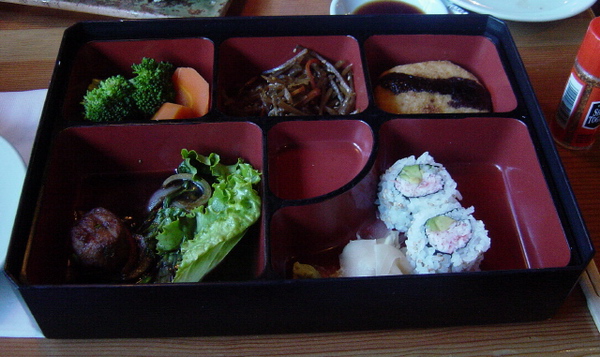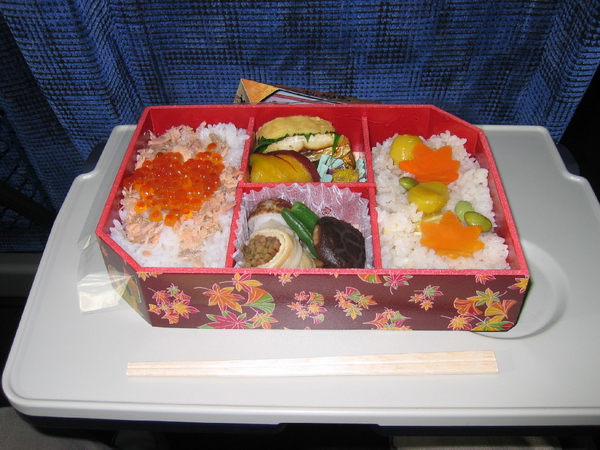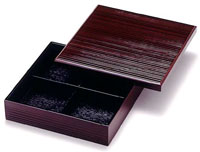Bento

Bento is Japanese for a single-portion takeout meal. A traditional bento consists of rice, fish or meat and one or more pickled or cooked vegetables as a side dish. Containers range from disposable mass produced to hand crafted lacquerware. While bento are readily available at convenience stores and bento shops (bento-ya) throughout Japan, it is still considered an essential skill of a Japanese housewife to be able to prepare an appealing boxed lunch.
History

The origin of bento can be traced back to the late Kamakura Period (1185 to 1333), when cooked and dried rice called hoshi-ii ("dried meal") was developed. Hoshi-ii can be eaten as is, or can be boiled with water to make cooked rice, and is stored in a small bag. In the Azuchi-Momoyama Period (1568 to 1600), wooden lacquered boxes like today's were produced and bento would be eaten during a hanami or a tea party.
In the peaceful and prosperous time of the Edo Period (1603 to 1867), bento culture spread and became more refined. Travelers and sightseers would carry a simple koshibento ("waist bento"), consisting of several onigiri wrapped with bamboo leaves or in a woven bamboo box. One of the most popular styles of bento, called makuno-uchi bento ("between-scene bento"), was first made during this period. People who came to see Noh and Kabuki ate specially prepared bento between maku (scenes). Numerous cookbooks were published detailing how to cook, how to pack, and what to prepare for occasions like Hanami and Hinamatsuri.
In the Meiji Period (1868 to 1912), the first ekibento or ekiben ("train station bento") was sold. There are several records that claim where ekiben was first sold, but it is believed that it was sold on 16 July 1885, at the Utsunomiya train station, and contained two onigiri and a serving of takuan wrapped in bamboo leaves. As early schools did not provide lunch, students and teachers carried bento, as did many employees. A "European" style bento with sandwiches also went on sale during this period.
In the Taisho period (1912 to 1926), the aluminum bento box became a luxury item because of its ease of cleaning and its silver-like appearance. Also, a move to abolish the practice of bento in school became a social issue. Disparities in wealth spread during this period, following an export boom during World War I and subsequent crop failures in the Tohoku region. A bento too often reflected a student's wealth, and many wondered if this had an unfavorable influence on children both physically, from lack of adequate diet, and psychologically, from a clumsily made bento or the richness of food. After World War II, the practice of bringing bento to school gradually declined and was replaced by uniform food provided for all students and teachers.
Bento regained its popularity in the 1980s, with the help of the microwave oven and the proliferation of convenience stores. In addition, the expensive wood and metal boxes have been replaced at most bento shops with inexpensive, disposable polystyrene boxes. However, even handmade bento have made a comeback, and they are once again a common, although not universal, sight at Japanese schools. (Their concomitant problems have not been avoided: the quality of bento is still very often a reflection of students' home situation.)
Bento is also popular in Taiwan. Bento made its way to Taiwan in the first half of the 20th century from Japan, where it remains very popular to the present day. The term is a loan word from the Japanese word in Taiwanese Mandarin.
In 2003, airports started offering an analogous version of the ekiben: bento filled with local cuisine, to be eaten while waiting for an airplane or during the flight.
How to make a bento

A bento is traditionally made in a 4:3:2:1 ratio: 4 parts of rice, 3 parts of the side dish (either meat or fish), 2 parts of vegetables, and 1 part of a serving of pickled vegetables or a dessert. However, almost anything can be used to make a bento.
Several precautions should be taken when making a bento. The most important thing is to avoid food poisoning, especially in summer. Foods should be cooked well and the bento must be stored in a cool, dry location. If sushi is a part of the bento, it should be prepared with more wasabi than normal. Foods covered with sauce should be carefully packed, or avoided altogether, as sauce may spill over on to the other foods. When cooked rice is a part of a bento, it should be cooled by leaving the bento open first. If a bento is closed before it is sufficiently cooled, the steam from the rice will condense inside the bento and make the food soggy.